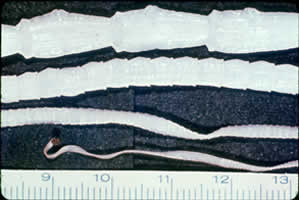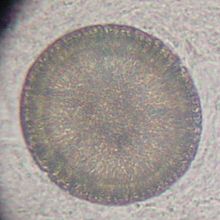Tapeworms
| Tapeworms | ||||||||||
|---|---|---|---|---|---|---|---|---|---|---|

Beef tapeworm ( Taenia saginata ) |
||||||||||
| Systematics | ||||||||||
|
||||||||||
| Scientific name | ||||||||||
| Cestoda | ||||||||||
| Rudolphi , 1808 | ||||||||||
| Subclasses | ||||||||||
|
The tapeworms , cestodes or cestodes ( Cestoda , from ancient Greek κεστός kestós , German 'belt' , Germanized from it also cestodes ) are long, flat worms with a small head, which is provided with suction cups or wreaths of hooks. They represent a class that belongs to the tribe of flatworms ( Plathelminthes ). Around 3500 species are known worldwide today, which are mainly attributed to the real tapeworms ( Eucestoda ).
External anatomy
Tapeworms live as endoparasites in the intestines and brains of various vertebrates.
To hold on to the intestinal wall, tapeworms usually have a ring of hooks with suction cups, the so-called scolex, on the front end . The gyrocotylidea instead have a rosette organ at the rear end .
Due to individual body sections, which are called proglottids , the real tapeworms in particular appear structured.
Tapeworm larvae lose their skin the first time they enter their host. Mesoderm cells from the inside of the body fuse with each other (syncystium) to form a new outer shell. It is known as neodermis . The worm ingests food through the neodermis, which protects it from being digested itself. Because of this neodermis, tapeworms are assigned to the neodermata along with other worms . In the tapeworms, the neodermis is particularly thick and has a border of microvilli , which in the real tapeworms also taper off at a point and thus form bristle-like structures, so-called microthreads . These serve to increase the surface area in order to make the absorption of food through the skin more effective.
Internal anatomy
A special feature of the tapeworms compared to the other representatives of the flatworms is their modified form of the excretory organs . Protonephridia also consist of a terminal cell , which swirls body fluid in a channel formed from cells by ciliate . The difference in structure affects this channel cells except those of the gyrocotylidea have no further eyelashes and represent a solid hollow cylinder in its construction, in contrast to the manner of a sleeve designed channel cells in other flatworms.
With a few exceptions, all tapeworms are hermaphrodites and accordingly have both male and female sexual organs . With regard to their equipment with sexual organs, a distinction is made between the Monozoic tapeworms and the real tapeworms:
Most tapeworms are real tapeworms. With them there is normally one sentence with both sex organs in a separate proglottis , although there are also species that have a double sex sentence in each of these body sections. After fertilization, the proglottids are pinched off individually and thus reach the outside via the host's faeces . In contrast, the Monozoic tapeworms have only a simple set of sexual organs and release their fertilized eggs through a porus into the host's intestine.
Way of life
All tapeworms are endoparasites and are very well adapted to this way of life. Both the larva and the sexually mature worms feed in the host without their own intestines.
The larvae usually form cysts , i.e. permanent stages in the tissue of an intermediate host , which only undergo a reproductive activity in the form of asexual reproduction in a few species such as the fox tapeworms ( Echinococcus multilocularis ) belonging to the genus Echinococcus . Normally, the cysts remain inactive until the tissue is fed into the intestine of the final host, where the larvae transform into adult worms.
The adult worms normally adhere to the intestine of the end host through suction cups or a ring of hooks, where they absorb the nutrients already released by the host's digestive enzymes directly through the skin. The neodermis , which changes the pH value around the animal and thus inhibits enzyme activity, serves as protection against the enzymes .
Cestodes which, as intestinal tapeworms, can cause parasitosis in humans are, for example, the fish tapeworm (Diphyllobothrium latum), the beef tapeworm (Taenia saginata), the pork tapeworm (Taenia solium) and the cucumber tapeworm (Dipylidium caninum). The underlying infections are treated with praziquantel or niclosamide .
Reproduction and development
Reproduction
In almost all types of tapeworm there is a change of host in the course of ontogenesis , in some species there is also a change of generation .
The Cestoda are bisexual and they produce innumerable offspring through cross-fertilization. Self-fertilization , in which the sperm cells from the testes of individual proglottids in the front part of the body fertilize the egg cells in the ovaries of the proglottids in the back part of the body , often occurs, particularly in many species of true tapeworms .
development
After the fertilized eggs get into the host's intestine, they are carried out in the feces. They remain here until they are taken in by a suitable intermediate host. The larvae of the tapeworms hatch from the eggs, which are equipped with a ciliated epidermis , which, like the neodermis formed afterwards, is already built up syncytially. In the case of very derived forms, such as the fish tapeworm , the larvae are completely absent. Like the adult worms, the larvae also have no intestines. The larval hooks with which the animals can hook themselves in the host tissue form an important anatomical structure. There are ten of these in the original forms and only six in the real tapeworms.
Systematics of tapeworms
Within the tapeworms, the Monozoic tapeworms are contrasted with the real tapeworms ( Eucestoda ). However, the former probably do not form a natural unit, but rather represent different stages of development in the evolution of the highly developed Eucestoda. Due to the systematics that have not yet been fully clarified, the classic variant should be used here:
- Tapeworms ( Cestoda )
- Monozoic tapeworms ( Cestodaria )
-
True tapeworms ( Eucestoda )
- Cyclophyllidea (for example the beef tapeworm Taenia saginata and the pork tapeworm Taenia solium as well as the dwarf tapeworm )
- Proteocephalata
- Pseudophyllidea (for example the fish tapeworm )
- Tetraphyllidea
- Trypanorhyncha
literature
- Peter Ax : The Metazoa system. A textbook on phylogenetic systematics. Volume 2. Gustav Fischer Verlag, Stuttgart et al. 1999, ISBN 3-437-35528-7 .
- Johannes Dönges: Parasitology. With special consideration of human pathogenic forms. 2nd revised and expanded edition. Thieme, Stuttgart et al. 1988, ISBN 3-13-579902-6 .
- K. Odening: 7th tribe of Plathelminthes. In: Alfred Kaestner : Textbook of special zoology. Volume 1: Invertebrates. Part 2: Hans-Eckhard Gruner (Ed.): Cnidaria, Ctenophora, Mesozoa, Plathelminthes, Nemertini, Entoprocta, Nemathelminthes, Priapulida. 4th completely revised edition. Fischer, Jena 1984, pp. 341-440.
- Reinhard Rieger : Plathelminths, flatworms. In: Wilfried Westheide , Reinhard Rieger (Ed.): Special Zoology. Part 1: Protozoa and invertebrates. Gustav Fischer Verlag, Stuttgart et al. 1996, ISBN 3-437-20515-3 , pp. 243-247.
- Jörg Blech: Life on Humans: The History of our Settlers . rororo sachbuch 62494, Reinbek near Hamburg 2010, ISBN 978-3-499-62494-0 .
Web links
Individual evidence
- ↑ See for example Hans Adolf Kühn: Darmparasiten. In: Ludwig Heilmeyer (ed.): Textbook of internal medicine. Springer-Verlag, Berlin / Göttingen / Heidelberg 1955; 2nd edition ibid. 1961, pp. 834-841, here: pp. 834-837: tapeworms (cestodes).
- ^ Marianne Abele-Horn: Antimicrobial Therapy. Decision support for the treatment and prophylaxis of infectious diseases. With the collaboration of Werner Heinz, Hartwig Klinker, Johann Schurz and August Stich, 2nd, revised and expanded edition. Peter Wiehl, Marburg 2009, ISBN 978-3-927219-14-4 , p. 290.

